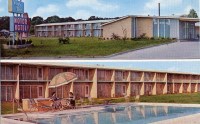Today’s post is the tenth in our reprint of the 1941 publication Mississippi Tourist Guide, which focused on the many attractions along Mississippi’s newly paved highways. (Check out the Intro if you missed it.)
 Dropping down straight through the predominantly rural sections of eastern Mississippi, Highway 15 reveals many interesting phases of Southern life. For a hundred miles or more after entering the state the route clings to the ridgelike land of shortleaf pine and small farms. Farther to the South the shortleaf pines give way to the majestic longleaf species, formerly the greatest industry of South Mississippi. Abruptly the highway drops from the pine hills into the shadowy river country. Moss-hung trees and a rich growth of vegetation borders the smooth pavement of the highway.
Dropping down straight through the predominantly rural sections of eastern Mississippi, Highway 15 reveals many interesting phases of Southern life. For a hundred miles or more after entering the state the route clings to the ridgelike land of shortleaf pine and small farms. Farther to the South the shortleaf pines give way to the majestic longleaf species, formerly the greatest industry of South Mississippi. Abruptly the highway drops from the pine hills into the shadowy river country. Moss-hung trees and a rich growth of vegetation borders the smooth pavement of the highway.
Walnut, Ripley and Blue Mountain by their names indicate the nature of the northern section of the state where highway 15 begins its long trek southward. At Blue Mountain is located Blue Mountain College for women and Mississippi Heights preparatory school for boys.
New Albany, where Miss. 15 junctions with U.S. 78 has retained much of the atmosphere of an old Southern town.
Pontotoc, 18 miles south of New Albany, provides an interesting insight into the past life of this individualistic section of the state.
Between Pontotoc and Houston is Natchez Trace State Park, newest of the state’s eleven state parks. Here, the traveler will find attractive cabin accommodations and many delightful recreational opportunities.

Houston contains the first Carnegie Library to be established in the state, as well as a number of homes as old as the town itself. In the vicinity of Houston are a umber of geologically interesting Indian mounds.
Maben and Ackerman, still in the hill section, are two important trading centers for the surrounding area.
At Louisville, 16 miles below Ackerman, is Legion State Park, a 424 acre tract of rugged woodlands, devoted chiefly to camping and picnicking. Cabins and a concession make it easy for the motorist to enjoy the opportunity of a few days in the open air.

Philadelphia, center of Mississippi’s Indian country, is the site of an ancient Indian village. Here is located the Choctaw Indian Agency.

Between Philadelphia and Newton is the small but progressive town of Union, which was burned to the ground by General Sherman. Decatur, county seat of Newton County, is located between Newton and Union.
At Newton, Miss. 15 junctions with U.S. Highway 80, which leads into Jackson, Capitol City of Mississippi.
At Bay Springs, Miss. 15 enters the longleaf pine section. Below Bay Springs the highway enters the wide-awake town of Laurel.
Laurel, a county seat of Jones, is a model of progress and diversification. Founded as a sawmill town, Laurel has adapted its economy to the changing culture of the times. The large Masonite plan, the sweet potato starch plant and the Mayhew canning plant are evidence of industrial progress; while the Lauren Rogers Library and Museum of Art, first art museum in the state, are evidence of the cultural attractions of this prosperous town.
Below Laurel, Miss. 15 passes through Richton, Beaumont and McLain, examples of South Mississippi towns that have abandoned the dying lumber industry for more profitable occupations, chiefly diversified farming.
Lucedale, where Miss. 15 turns into the state line, is noted for the Luce Farms, an experiment in diversified farming.
More about Highway 15 and other Mississippi highways . . .
Categories: Blue Mountain, Historic Landscapes, Hotels, Houston, Laurel, Louisville, Roadside









a lot of good information here to spark some conversations, such as ms heights boys school at blue mountain and the ‘first ms carnegie library’ in houston==new data for me,. guess i have been to all of the places on 15 but not recently. great (great!) ad for the pinehurst hotel!
how many more highways do we have in this series? i could imagine ‘quite the book’ which would combine the original material from the brochure plus the m pres comments! maybe a separately filed link—like the trolleys?
LikeLiked by 1 person
I love this series, too. It has introduced me to some places in Mississippi I have never heard of, let alone visited. It makes me want to take a trip across the state. This highway narrative does not seem to have as much flair or interest as the previous highways, with “Southern town” sounding like the common factor.
LikeLiked by 1 person
Yes, i especially noticed this when i started to compile the “see more of highway 15” at the bottom of the post. The writer didn’t mention many specific sites in each town that I could search for, so I was left with a pretty scrawny list of other related posts.
LikeLiked by 1 person
On the other hand, I continue to be struck by the writer’s interest in the flora of Mississippi, especially varieties of pine trees.
LikeLiked by 1 person
Yes, I have noted the pine trees got a lot of press.
LikeLike
will ask again, how many more of our state’s highways are there ‘to go’?
LikeLike
Four more, including the neglected Hwy 49-E
LikeLike
As a recent engineering graduate of Mississippi State (in 1937), my father went to work for the highway department and designed many of these roads. Brings back memories traveling on them visiting grandparents, aunts, uncles and cousins as a child!
LikeLiked by 2 people
just did some quick ‘homework’ on both mississippi heights (boys) school at blue mountain and the carnegie libr in houston—- some interesting data! will quickly summarize, but recommend that anyone interested in either/both of these topics, hit the net!
m h boys school was founded in 1904 by dr b g lowrey, who was also the founder of blue mountain college(women) in the same town; to have both mens’ and womens’ schools in the same muncipality was typical of the 19th and e 20th centuries—look at clinton’ s ms college(my maternal grandfather ‘s alma mater) and hillman college(that attended by my maternal grandmother)attended). ms heights lasted until 1947 when the director, j e brown(who had purchased the school in 1914) died; according to my net research, it educated over 4000 boys in the course of its existence, the main building was a quirky towered victorian with architectural detais from several different styles; it survived until 1957, and today, a monument marks the site.
(i believe the lowrey family of hattiesburg—-leonard lowrey was the editor of ‘the hattiesburg american’ for many years– backyard neighbors to my family when i was growing up–was related to dr lowrey of blue mountain–mr gentry might be able to corroborate this assumption.)
the carnegie library in houston has several distinctions–one of which is the fact the the original building, ca 1909, kind of arts-and-crafts/prairie style stands, it remains the municipal library, and it is well loved by the community. the structure was added to the national register in 1978, and the good description was done by ms adele cramer at mdah. yes, it was the first carnegie library in ms, instigated by a letter to carnegie from the local supt of schools; the carnegie gift of $6000 funded construction but, as was usual in those gifts, the continuing maintenance was the community’s responsibility., the houston facility was the 2nd public library in the state, biloxi’s in 1898, being the first. surprisingly, at the time the nr nomination was written, the architect was unknown— has this changed, i wonder? there must be architects who worked in that area–presumably from larger cities in ms, tn, or al–that could, at least, be given as an attribution, mr white, any ideas?
LikeLike
P. J Krouse? Old Lee High in Columbus
One of the St. John brothers of Brooksville was associated with the Hattiesburg-American in the 1950s. That would be food editor Robert St. John’s grandfather. Another St. John brother was principal of the Brooksville High School which was designed by P. J. Krouse. Through the efforts of Krouse and Senator Bilbo, the Brooksville school was completed after the WPA program ended in 1943. After spending $50,000 from the initial 1941 WPA grant, the school was only two-thirds complete when the school programs ended and funding terminated. Senator Bilbo was able to get a “Presidental” commitment to see that the school project was completed, which, I recall, was funding another $28,000 in 1943-1944. Krouse died in 1944.
LikeLike
R.H. Hunt of Chattanooga, according to the MDAH online database: https://www.apps.mdah.ms.gov/Public/prop.aspx?id=3438&view=facts&y=1160
LikeLike
well, i should be doing something else, but…. and, it’s rainy and cold here today, so don’t think i am going out on my errands,.
a good description of earlier members of the lowrey family is at, andspeakingofwhich.,blogspot.com—which would seem to confirm my suspicion that hattiesburg’s leonard lowrey was related to the blue mtn lowreys(although leonard isn’t mentioned); and, there is a good description of ms heights school in mary carol miller’s ‘ lost landmarks of ms’. when i i found the latter on the net just now, there was a blank where a photo of the school’s main building might have been— i will guess that this photo is the one that i found on the net,
LikeLiked by 1 person
P. J. Krouse was chairman of the Wartime Rationing Board in Meridian during the time of the Brooksville school construction.
LikeLike
Bay Springs is also where the old Jackson Military Road crossed the Upper Three-Chopped Way (St. Stephens to Natchez) . I hope someday Misspreservation.com will add some information on the Old Jackson Road.
LikeLike